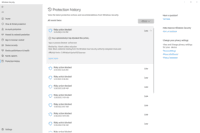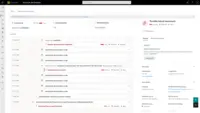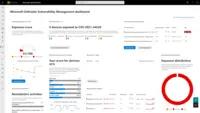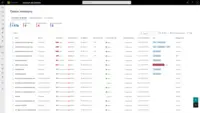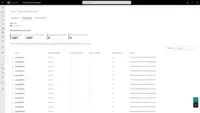Microsoft Defender for EndpointFormerly Microsoft Defender ATP
Overview
What is Microsoft Defender for Endpoint?
Microsoft Defender for Endpoint (formerly Microsoft Defender ATP) is a holistic, cloud delivered endpoint security solution that includes risk-based vulnerability management and assessment, attack surface reduction, behavioral based and cloud-powered next generation protection, endpoint detection and response (EDR), automatic investigation…
Perfect Endpoint Security, Exposure Detection and Management Tool.
Microsoft Defender for Endpoint Review
Quick to rollout and get going, but takes some tweaking to optimize.
Microsoft Defender Review
The one stop security shop for the endpoints
Decent Protection for your endpoints
Microsoft Defender for Endpoint, a must for every Windows based IT setup
"Microsoft Defender for Endpoint One of the best tool to manage threat, Vulnerability and Compliance of the endpoints."
Secure workstations with MDE
Defender for Endpoint - First class EDR and more.
A Comprehensive Look at Microsoft Defender for Endpoint. Defending with Style
Defend, Detect, Excel with Microsoft Defender for Endpoint
Microsoft Defender for Endpoint
Microsoft defended for endpoint user experience review.
How Microsoft Defender for Endpoint Differs From Its Competitors
Components
Protection Scope
Components
Protection Scope
Components
Protection Scope
Components
- Attack Surface Reduction helps us proactively block commonly used attack methods by malware (scripts).
- We use Microsoft Defender for Endpoint as a layered approach with other security tools.
Protection Scope
Components
- Vulnerability Management
- Baseline Assessments
- Device Discovery
- Endpoint Security Policies
- Automated Remediation
- Dynamic Device Tagging
- Endpoint DLP
- Web Content Filtering
- Live Response
- Unified integration with Defender for Cloud
- Always remediate PUA
- Device Deception (Preview)
- Download quarantined files
- Evaluatio…
Protection Scope
Components
Protection Scope
Components
1. Centralised deployment of antivirus agent
2. Centralised monitoring of security alerts
3. Vulnerability management
4. Antivirus and anti malware
5. Integration with Microsoft Intune
6. Device …
Components
Endpoint Detection and Response (EDR) : Organizations can investigate security incidents, collect pertinent data, and implement the necessary remediation activities to eliminate and contain threats by using …
Protection Scope
We are protecting over 30 Windows devices for our company, as well as more than 50 Windows and macOS devices for one of our customers. We also use Microsoft Intune to manage over …
Components
2. Advanced Threat Protection
3. Attack Surface Reduction
Protection Scope
Components
Protection Scope
Components
Threat & Vulnerability Management
Intune Integration
Microsoft Defender Antivirus
Microsoft Defender SmartScreen
Attack Surface Reduction
Components
Protection Scope
Components
Protection Scope
Components
Protection Scope
Components
Protection Scope
Components
Protection Scope
Components
Protection Scope
Components
Protection Scope
Components
Protection Scope
Components
- Attack Surface Reduction (ASR).
- Next-generation Protection.
- Microsoft Secure Score for Devices.
- Automated Investigation and Remediation (AIR).
Protection Scope
Components
Protection Scope
Components
Components
Protection Scope
Components
Protection Scope
It manages the endpoint weaknesses …
Awards
Products that are considered exceptional by their customers based on a variety of criteria win TrustRadius awards. Learn more about the types of TrustRadius awards to make the best purchase decision. More about TrustRadius Awards
Popular Features
- Malware Detection (52)8.585%
- Infection Remediation (51)8.282%
- Anti-Exploit Technology (50)8.080%
- Centralized Management (51)7.979%
Reviewer Pros & Cons
Pricing
Academic
$2.50
Standalone
$5.20
Entry-level set up fee?
- No setup fee
Offerings
- Free Trial
- Free/Freemium Version
- Premium Consulting/Integration Services
Product Demos
Microsoft Defender for Endpoint Overview
Features
Endpoint Security
Endpoint security software protects enterprise connected devices from malware and cyber attacks.
- 8Anti-Exploit Technology(50) Ratings
In-memory and application layer attack blocking (e.g. ransomeware)
- 8.5Endpoint Detection and Response (EDR)(50) Ratings
Continuous monitoring and response to advanced internet threats by endpoint agents.
- 7.9Centralized Management(51) Ratings
Centralized management supporting multi-factor authentication, customized views, and role-based access control.
- 7.8Hybrid Deployment Support(10) Ratings
Administrators should be able to choose endpoint security on-premise, cloud, or hybrid.
- 8.2Infection Remediation(51) Ratings
Capability to quarantine infected endpoint and terminate malicious processes.
- 8.3Vulnerability Management(49) Ratings
Vulnerability prioritization for fixes.
- 8.5Malware Detection(52) Ratings
Detection and blocking of zero-day file and fileless malware.
Product Details
- About
- Competitors
- Tech Details
- FAQs
What is Microsoft Defender for Endpoint?
Rapidly
stops threats: Protects against sophisticated threats such as
ransomware and nation-state attacks.
Scales security: Puts time back in the hands of defenders to prioritize risks and elevate the organization's security posture.
Evolves the organization's defenses: Goes beyond endpoint silos and mature the organization's security based on a foundation for extended detection and response (XDR) and Zero Trust.
Microsoft Defender for Endpoint Features
Endpoint Security Features
- Supported: Anti-Exploit Technology
- Supported: Endpoint Detection and Response (EDR)
- Supported: Centralized Management
- Supported: Infection Remediation
- Supported: Vulnerability Management
- Supported: Malware Detection
Microsoft Defender for Endpoint Screenshots
Microsoft Defender for Endpoint Video
Microsoft Defender for Endpoint Competitors
Microsoft Defender for Endpoint Technical Details
| Deployment Types | On-premise |
|---|---|
| Operating Systems | Windows |
| Mobile Application | No |
Frequently Asked Questions
Comparisons
Compare with
Reviews and Ratings
(174)Attribute Ratings
Reviews
(1-5 of 5)Holistic approach to Cybersecurity
- Compatible with macOS, iOS, Android, Windows Server, Windows 10 and Linux
- It runs natively on Windows it is not a bolted on solution. Once you have the correct license it is easy enough to light up the application to protect the endpoint
- Integrated with Microsoft Intune
- It is designed to detect and remediate adversary tactics from the MITRE knowledge base.
- Microsoft analyzes billions of signals daily to detect attacks against O365 tenants these same signals are fed into ML to further fine-tune MDE. How many other solutions out there will have access to this vast amount of data to analyze to train their ML?
- Automated detection and remediation of threats with a graphical timeline view of how the treat got into the device and was stopped
- It has its own vulnerability scanner to feed data into the dashboard so you can see daily which endpoints need to be patch first based on its value
- It comes with an advanced hunting tool using the kusto query language to search your tenant for threats
- It can keep 180 days of log data
- From one bundled license I can protect Exchange online email, Sharepoint, Microsoft Teams, One Drive, Azure identities, AD, endpoints
- Web filtering on the macOS it not available yet
- They recently made it easier to on-board macOS endpoints using Microsoft Intune by deploying it as an app. It used to take a lot of more configuration profiles to set up. For older macOS Sierra using the older extensions it will still require the multiple steps to on-board to MDE
- They need to integrate Microsoft Cloud app into the new dashboard of MDE
- Reduce the memory overhead of the mdatp agent running on Linux
- Holistic cybersecurity tool
- Compatibility with all of my OS
- It is like having my own SOC for my small organization
- Anti-Exploit Technology
- 100%10.0
- Endpoint Detection and Response (EDR)
- 100%10.0
- Centralized Management
- 100%10.0
- Hybrid Deployment Support
- 100%10.0
- Infection Remediation
- 100%10.0
- Vulnerability Management
- 100%10.0
- Malware Detection
- 100%10.0
- You will have to move up to Microsoft 365 E5
- You can get rid of other 3rd party security tools and just use the Microsoft ecosystem
- Product Features
- Product Reputation
Microsoft Defender ATP offers a great alternative to traditional, and even cloud-based AV.
- Visibility: It's great to be able to see what KBs are missing, etc.
- Lightweight AV protection built on the already included Windows Defender Application
- Deployment: We've had some issues deploying, especially outside of the Windows environment.
- Offboarding: There is currently no way to delete a computer. They disappear over time. We even renamed a computer, and it kept both the old and new name in there. Eventually, the older machines do go away, but there is no manual way to do this at the moment.
Where it may not be great is in mixed-OS environments. It requires a bit of determination to get ATP installed on OSX or Linux. While these platforms do get fewer viruses in general, it's good to have the layer of visibility and security for web and browser based threats.
- Anti-Exploit Technology
- 90%9.0
- Endpoint Detection and Response (EDR)
- 90%9.0
- Centralized Management
- 100%10.0
- Hybrid Deployment Support
- 30%3.0
- Infection Remediation
- 80%8.0
- Vulnerability Management
- 80%8.0
- Malware Detection
- 90%9.0
- It's less expensive than our previous AV, which was a bit more traditional and included a support suite of apps.
- It's prevented viruses, which in turn increased production.
We also used to use Kaseya to get visibility on stuff like patches, etc. To be honest, most of the data we can get from ATP is sufficient, and another product like that, or Panda Systems Management, seems so close to redundant, bar one or two small features.
Microsoft Defender Review
- One of the undeniable strengths of Windows Defender is that it is free. It already comes packaged with Windows. You don't have to install separately or pay extra for the excellent kind of protection it provides.
- Unlike all the other anti-virus software out there, the service is very light on the system and one doesn't even get to know when a background check is going on in the background. I never had to open the application to run scans. It automatically keeps running in the background and informs if anything fishy is going on in the background.
- When it comes to the latest threats and malware, it is not the most updated antivirus software in the market. It can always benefit from quick virus definition updates.
- It is not a complex antivirus solution when it comes to its feature sets. People who are finicky about each and every feature will be a little disappointed with the lack of options/settings available to configure the antivirus.
- Anti-Exploit Technology
- 70%7.0
- Endpoint Detection and Response (EDR)
- 80%8.0
- Centralized Management
- 70%7.0
- Hybrid Deployment Support
- 90%9.0
- Infection Remediation
- 80%8.0
- Vulnerability Management
- 90%9.0
- Malware Detection
- 90%9.0
- There is definitely a piece of mind provided when you know that your system will not get compromised because of malware and viruses.
- The fact that I don't have to spend money in the first place means that I can spend money on other more important things that do require it.
Great AV solution that's low on system resources!
- It does not take up a lot of system resources, unlike other 3rd part AV providers.
- Integrated into the MS product line without having to touch it too much, unlike 3rd part AV providers.
- Easy to set-up and manage endpoints.
- It does not break Windows OS like 3rd party AV providers whenever a patch or roll updated is deployed.
- Detection rates are less than some of the competitors out there.
- Too many false positives with 3rd part applications.
- For smaller deployments can get expensive compared to competitors.
- Anti-Exploit Technology
- 80%8.0
- Endpoint Detection and Response (EDR)
- 80%8.0
- Centralized Management
- 100%10.0
- Hybrid Deployment Support
- 90%9.0
- Infection Remediation
- 80%8.0
- Vulnerability Management
- 90%9.0
- Malware Detection
- 70%7.0
- The ROI on MS ATP has paid for itself as soon as it was deployed and caught and prevented virus and malware threats which saved our IT staff time and money.
- Since MS ATP is low on system resources it enables us to stretch out hardware an additional year.
- If you require stability in your business operations MS ATP is a must.
A really good all-in-one antivirus/malware/threat product
It address the business problem of helping to protect every computer that connects to the network, or that connects to the domain. All policies/settings get pushed down to the clients that are installed on the individual machines. There doesn't need to be user interaction to get this done
- It is great at proactively monitoring threats across the network. It works seamlessly with the client to monitor individual user computers, and it has a good real-time scanning engine.
- On the client side, Windows Defender doesn't require a whole lot of system resources to run, nor will it create unnessary slowdowns of a computer, even while scanning for threats
- We've noticed one issue with the SmartScreen filter settings on the client and trying to install programs. If the Administrator sets the setting to Block on the server side, then this might interfere with some programs trying to get installed on the client side. Microsoft should look into this issue, and maybe offer more sub-settings for the Block option
- Noticed that Windows Defender will occassionally do a system scan on a client during business hours, even though on the server side, scans are set for the middle of the night. This does not occur on all endpoints, or at all times, but tends to be random
It might be less of ideal solution if a company/organization were looking for something more robust, or had a lot more features/configuration settings. It also might be less ideal for a company/organization that was looking for a product that didn't have a high detection rate of false positives
- A positive impact has been to increase productivity for IT staff, as it saves them time from having to install/configure clients on every endpoint.
- Another positive impact has been on the user/client side, as it helps the user to increase their productivity with working on their computer, as the Windows Defender client uses little resources to run on the system, and has a tendecy to not slowdown systems
- Symantec Endpoint Protection, Microsoft System Center Endpoint Protection, Webroot Business Endpoint Protection and McAfee Endpoint Security
Antivirus/malware detection rates have improved a lot over the years with Windows Defender. It used to be they fell behind in detection rates, but not so anymore. The big thing that must be approved upon is the detection of false positives, which other products may have an edge over them in this regard



